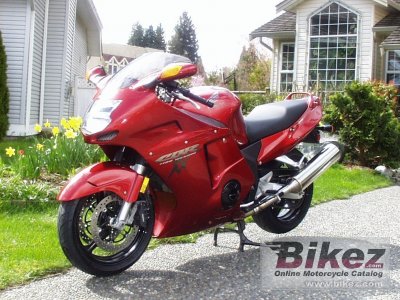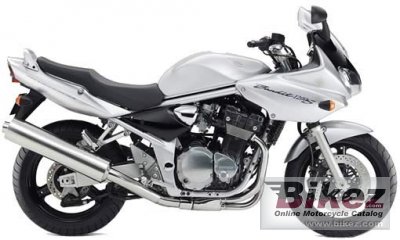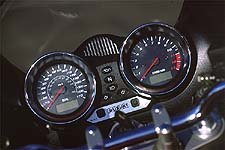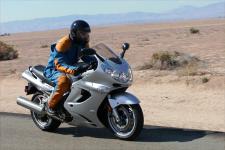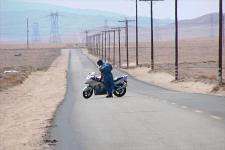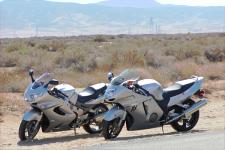Source:http://www.motorcycle.com/shoot-outs/honda-cbr1100xx-vs-kawasaki-zzr1200-15400.html
Break out the Good Silverware
Torrance, California, September 29, 2002 --
These two lovelies were both cutting-edge big bikes built for the top-speed battles of the mid-1990s, until a bike named after a falcon called the Hayabusa came along and changed motorcycle history like only a small percentage of models ever do. It effectively relegated bikes like the venerable Blackbird and the ZX-11 (aka ZZ-R1100 in Europe) to second-tier status and opened up the market for other wacky shenanigans from Nippon, like the ZX-12R and the GSX-R1000.
One of the side effects of all this activity was an unofficial high-speed moratorium put into effect in 2000 with a lid of 300kph/186mph rumored to be the "gentlemen's agreement" among the major bike manufacturers (much like the 155mph top speed limit agreed upon by most European car makers).
But I digress: For what purpose do dinosaurs like the Dos Equis and the Zee-Zee-R exist, with monsters like the Hayabusa and ZX-12R stomping around?
"These bikes have become de facto sport-touring bikes, or Grand Touring (GT) bikes." Honda's continuing refinement of the venerable CBR1100XX and Kawasaki's further shift towards the sport-touring sector with the redesign of the ZX-11 into the ZZ-R1200 reflects this. The Honda is a smooth, sophisticated bike that screams refinement. Its styling is still sharp, and combined with its smart silver paint scheme, it gathers many compliments and admiring glances.
The dash is a myriad of digital readouts and the engine is as smooth as "I Can't Believe it's Not Butter."
Compared to the Honda, the new ZZ-R seems unrefined and a bit industrial at first glance--not surprising, as it's built by a corporation that also builds bridges and commercial gas turbines. Analog gauges stare at you as if from an old fighter plane's cockpit, the engine is guttural and buzzy, and the styling is still open to debate. But things start to make sense after you spend some time on the bike and you notice details that Honda failed to address even in their years of refinement. Things like a handy little U-lock storage space, an easy-to-reach rear preload adjuster and front preload that is adjustable in the first place, start making me wonder why the XX is 500 clams more?
Well, probably for things like a counterbalanced engine, fuel injection, the entertaining digital dash and the linked braking system--all of which I am content to live without. Not that I'm a technology-hating Luddite--far from it, and in fact, I consider myself much more of a technophile. Sure the big Kawasaki is a little buzzy, but as long as you keep the revs above 5000 rpm on the freeway and don't lug it down, you'll avoid the onset of hand-tingling numbness. (To accomplish this means either cruising above 90mph or dropping down a gear; I'll leave the choice up to you.)
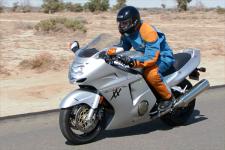
The Honda's engine, on the other hand, is smooth everywhere, with lots-o-power at your fingertips. The fuel injection of the XX also carries certain advantages, such as quick startup and rapid warm-up time, but we prefer the carbureted power delivery characteristics of the ZZ-R. It's not as snatchy as the Honda, and overall a little more natural and fluid feeling. When news of this bike's release came out, the dreaded phrase "tuned for midrange performance" was part of the propaganda, but as it turns out this engine still feels fairly peaky for a 1200--with a whole lotta mojo everywhere on the tachometer's diabolically orange glowing face.
The only downside is that it can trick you into how potent it really is and how fast you really are going on the open road. It really doesn't want to cruise below 90-- nice for covering ground, but potentially not so great for the 'ol driving record.
Much like the Honda's FI compared to the Kawasaki's rack of carbs, the digital vs. analog theme continues between these two bikes. The dash of the Honda is well-designed and informative, but also a bit cluttered and distracting.
The Kawasaki's old school analog pieces provide every bit of pertinent information you need instantly and easily, even if the numbers on the speedo are a bit crowded. As much as "digital" has become the magical buzzword of our era, analog is still not a bad word as long as it's in the right context.
"When it gets to bikes this fast, it's splitting hairs to try and compare which one's faster."
One item we could live without on the Honda's parts list (and something that we'd gladly trade for front preload adjustability and easy rear suspension adjustment) is the Linked Brake System. It's a normal journo gripe which we tried to avoid but can't. Around town the system is fairly transparent and not very noticeable, but get it in a backroad environment and it can be unsettling for riders who like to settle the front or rear independently going into corners, which would be nearly all of us. The Kawasaki's brakes aren't really fantastic or anything, but they do their job predictably and reliably, and in general make you wonder why Honda goes to all the trouble? Honda's ABS is fantastic on models that have it, but LBS? It's tough to figure out the motivation at the end of the day.

Speaking of things like corners and backroads, the opinions formulated after taking these bikes through a variety of conditions were surprising. The Double X is quite nice around town; calm, composed, and with a smaller feel than the Kawasaki it's easier to ride, but that's not what these bikes are built for.
Sure, they go hellaciously fast: Unsanctioned blasts on overhead carpool lanes and across the desert confirmed something that we all know to be true (*cough* 175 indicated, cough cough!).
When it gets to bikes this fast, it's splitting hairs to try and compare which one's faster (170mph vs. 175, how fast do you need to get to that dentist appointment?). That said, the Kawasaki's monstrously powerful and torquey engine easily pulls away from the Honda at supra-triple-digit speeds. In the midrange, too, the ZZ-R lunges ahead from 5000 rpm while the Honda sort of eases into its harness.
So what happens when it comes time for the straightline fun to end and make that inevitable bend in the road?
On the first such backroad outing I was on the Zed, behind Speedy McSpeed Calvin on the EcksEcks and thought, Oh just you wait, I'll catch up with you when I get on the Honda! Hah hah hah hahhhh... but to my shock and dismay, after we switched bikes I found myself dropping even further behind than normal and pining away for the rough and tumble Kawasaki.
This was the complete opposite of what we'd expected; after riding the bikes on short trips around LA I thought for sure the Blackbird (Silverbird?) would spank the ZZ-R in the backroads and twisty bits. It sure feels smaller and more sportbike-ish: lighter, narrower, a forward seating position, more weight on the wrists, and narrow handlebars. But the Kawasaki is a big surprise once you get it on what you would expect to be the Honda's turf. Its girth and weight seem to disappear and it's actually a lot of fun to ride at a sporting pace. Its growling intake makes you want to open the throttle for more visceral reasons than just an onrush of stupid amounts of power and torque. Think of a late model V8 Camaro or Trans Am. The Honda's more like an Acura Integra.
ZZ-R handling is predictable and instills complete trust in its abilities, but it's still surprisingly quick and light. Some of us found ourselves getting into far more "oh-shit" situations on the Honda; things like rippled pavement illustrate the differences. Mr. Honda bounces and complains, but Mr. Kawasaki just seems to jump over it all and laugh in the process. It takes a lot to faze this big machine. Another plus is that its hugeness is a definite advantage on long trips.
"The Kawasaki's bulbous fairing provides great wind protection for gangly frames, and was incredibly comfortable during a nonstop run across the desert to Las Vegas for an overnight jaunt to see the "Art of the Motorcycle" exhibit." The wide seat spreads out your weight evenly, and makes even butts with not much padding feel perfectly comfy.
Compared to the CBR, it's a rolling La-Z-Boy. Overall, the ZZ-R's like that well-worn Barcalounger in front of your grandpa's TV, and the CBR's more like a firm executive chair. It's relatively plush as far as sportbikes go, but after an extended exploration voyage up the coast on a Sunday afternoon, I was ready to be done.
My butt, wrists and neck had enough by the time I'd put in over six hours on the Honda. The compactness that makes it feel better in the city doesn't provide as much wind protection at elevated intercity speeds, the forward and compact ergoes weren't so kind on my freakishly long extremities, and the narrower and firmer seat wasn't as nice either.
One drawback of all the horsepower these bikes develop is the production of a lot of waste heat that has to be dumped, and the Honda in particular seems to put off a lot. Riding it around in 90-degree-plus weather with full gear is not a pleasant experience if traffic gums up at all, and in L.A. it always does. As for traffic, lane splitting on either of these bikes is a snap, as they do have a certain presence on the asphalt.
And interestingly enough, I had the opportunity to both be a passenger on the CBR1100XX with JohnnyB at the helm and to carry one for a little while myself. It's actually pretty nice back there, and my relatively inexperienced passenger felt quite secure. However, from the pilot's perspective, I didn't like how the passenger upset the balance of the machine. (Unlike every other Honda designed to carry a passenger, for some inexplicable reason this one makes rear preload adjustment a knuckle-busting affair.)
They're both excellent bikes and fantastic all-around machines, particularly if you have a long commute or live in Montana, where they can take a deep breath, stretch their legs and gallop up to an easy one-thirty for a while. If we've got to pick one, though, it's the ZZ-R1200. It's big, fast and fun to ride. Cool noises waft upward from its mechanical guts, it goes like greased stink, and the engineers really paid attention to all the little details that matter. Nice bike.
Unsolicited Input
John Burns
Just goes to show you. When I first rode the new ZZ-R several months ago, not for long, I was less than impressed. It reminded me of one of my all-time favorite bikes though--the CBR-XX. Comparing the two seemed like an excellent pretext for borrowing one from Honda for awhile. Calvin and the Stickman both loved the Kawasaki immediately. Here's a chance to teach the lads a lesson, I thought. Boys, when the XX gets here, you'll discover what a pile of junk that rehashed Kawasaki is. The XX, lads, is a polished gem, a smooth, swift chariot fit for the moto-sophisticate, and by then they would've wandered off. Um, when I actually put miles on them back to back, I realized the kids are right. It's the Honda's suspension that actually feels a bit overdamped and choppy. And while the ZZ-R engine is a bit coarser, it makes so much more power than the supersmooth Honda, you don't mind a bit. Pardon us for taking such a long time to test the ZZ-R, but I did not expect it would be such a nice `sickle.
Calvin Kim
I came into this test with somewhat of an open mind. I had ridden the XX before, but didn't really remember all the details. The ZZ-R, course is all new. Anyway, when it came time to take one home for the night, I first hoped on the ZZ-R. The growling intake sentiment is right. This thing has cajones and isn't afraid to tell you. I appreciated the remote preload adjuster, and found the dash and ergonomics to be utilitarian and just right for me.
Then came the XX. Talk about smooth, when I was riding the XX, the only thing that I could think of was when turbine-powered aircraft was first introduced to the public. However, the smoothness comes from its counter-balancer equipped engine, not from its suspension, and thats where bikes like these need the smoothness the most.
The ZZR, on the other hand, was just a fun bike. It's a big machine that can be used for just about any sort of task. I like to think of it as a BMW 5-series but on two wheels. That is, I'd think of it that way if you could ignore the buzzing. What wasn't fun, however, was its dyno graph. If you look at it, the Honda makes more power above 7,000 rpm. But during our own straightline testing, the Kawi was superior. I'm thinking the ram air system on the Kawi might be the cause of that. Regardless, I had the most fun on the ZZR through hill, dale and all points in between.
| Honda CBR1100XX | Kawasaki ZZ-R1200 |
| Engine | 1137cc liquid-cooled, 16-valve, DOHC inline four | 1164cc liquid-cooled, 16-valve, DOHC inline four |
| Bore x Stroke (mm) | 79.0x58.0 | 79.0x59.4 |
| Compression Ratio | 11.0:1 | 10.5:1 |
| Ignition | Digital |
| Fuel Delivery | EFI | 4x Keihin CVKD40, TPS |
| Transmission | 6-spd, wet, multiplate clutch |
| Suspension, Front | 43mm, 4.7" | 43mm, 4.8" (P) |
| Suspension, Rear | Mono-shock, 4.7" (P-threaded,R) | Mono-shock, 4.8" (P-threaded) |
| Brakes, Front | 310mm, 3 piston | 320mm, 4 piston |
| Brakes, Rear | 256mm, 3 piston | 250mm, 1 piston |
| Tires, Front | 120/70ZR-17 | 120/70ZR-17 |
| Tires, Rear | 180/55ZR-17 | 180/55ZR-17 |
| Wheelbase | 58.5"/1486mm | 59.3"/1506mm |
| Rake-Trail | 25.0°-3.9"/99mm | 25.0°-4.16"/106mm |
| Seat Height | 31.75"/806mm | 31.50"/800mm |
| Thumb Height | 37.25"/946mm | 37.25"/946mm |
| Thumb-to-Thumb | 19.0"/483mm | 20.0"/508mm |
| Fuel Capacity | 6.3gal/29L | 6.1gal/28L |
| Fuel Mileage | 43mpg | 36mpg |
| Measured Weight (wet) | 552lbs/250kg | 595lbs/270kg |
| Available Colors | Metallic Silver | Galaxy Silver |
| Suggested Price | $10,999 | $10,499 |
(P,C,R) denotes adjustable Preload, Compression damping and Rebound dampening.
threaded and ramp denotes method of rear shock preload adjustment. Threaded collar, or ramped collar.
Front brakes come in pairs. We assume this to be common knowledge so we didn't mention anything about it. If you didn't know this information, don't worry, you're informed as of now. |
Read more...








